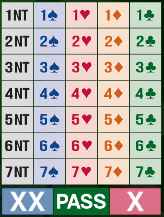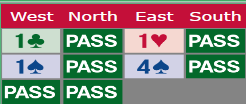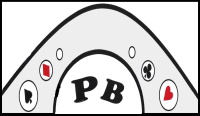So you have played some minibridge and have got to grips with the mechanics of game-play. What next? Now is the time to tackle the other half of the game of bridge – bidding!
What is the aim of bidding?
The primary goal of bidding is to arrive in the most suitable final contract for your hands. You need to make sure that you have a good chance of making your tricks, but equally you dont want to make a lot more than you bid!
There are a total of 35 possible final contracts for a bridge hand. Each suit, including no trumps, can be played at any level from 1 to 7.
For a 1 level contract you will need to make 7 tricks. Each level requires an extra trick, so a 2 level contract requires you to make 8 tricks, a 3 level contract 9 tricks and so on. For a 7 level contract you will need to make all 13 tricks, this doesnt happen very often!
Low level contracts are known as part-score contracts. If you make them then you will get a small number of points. What you really want is a hand which can make Game. If you can make a game level contract you will get a BIG bonus.
Game changes depending on the suit –
- NT – 3 level contract – 9 tricks
- ♠/♥ – 4 level contract – 10 tricks
- ♦/♣ – 5 level contract – 11 tricks
You can see that it will be easier to make game in NT or a major if you have a suitable hand. Bidding game in a minor suit is rarer and should only be done if there is no alternative game available.
How does the bidding section work?

Bidding is best viewed as a conversation between partners about their hands, but in this conversation we don’t use words we use bids. There are a finite number of bids available to a player – each suit (including no trumps) can be bid at levels 1 – 7. There are also Pass cards and Doubles. Each bid has its own meaning, which may be different to the face value of the bid.
Once the hand has been dealt it is the dealers turn to bid first. The dealer on hand one will always be North and it will rotate clockwise with each hand. Even if you are playing online a dealer will be assigned so that you know who is to bid first. It should always tell you on the screen somewhere who is dealer.
If you are the first to bid you must have at least 12 high card points in order to open. If you have less than 12 points you should pass and the bidding will pass to the next player.
If you have 12 points then you can start the bidding. The aim is to see if you can find an 8 card fit in a suit with partner. For this reason your first move will usually be to open 1 of your longest suit.
If your partner opens the bidding and you have 6 or more points you must respond. For details on opening bids and responses please refer to the relevant learning pages.
The bidding continues until three players in a row pass. The contract is the last bid to be made and is played by the first person to bid that suit. Here is an example.

In this auction West was the dealer so they opened. The last bid made is 4 spades, so that will be the contract. West was the first person to bid spades and so they will be declarer and East will be dummy.
The opening lead always comes from the player to the left hand of declarer. Opening lead is made before dummy goes down on the table in full bridge.
To start learning bid meanings and sequences it is best to start with our guides on either 1 of a suit openings or 1NT openings.
